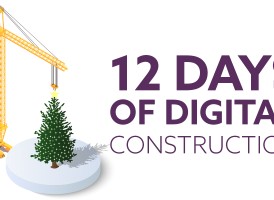
12 Days of Digital Construction
18 December 2020
This Christmas, after such a transformational, innovative and challenging year we’re bringing you...
28 May 2024 | By NBS
Manufacturers who strive to better understand and facilitate an architect’s design process will be more likely to win work from the specification stage. One important concept is that of design intent, which affects not only the project and final build, but also the materials used.

As a construction manufacturer, you can help architects realise the design intent behind their projects at the specification stage. Doing so helps you better establish your brand as an industry leader and makes your product integral to the final project, reducing the risk of being swapped out.
So what is design intent, and how can you interact with architects at specification to help facilitate it? Let’s take a closer look.
Design intent is a simple concept on the surface, but it’s one that has more complex considerations when you begin to analyse it further. Conceptually, design intent is simply the intended purpose of the building.
Architects must consider a few questions when approaching the initial design: who is it for, why is it being built, and what will it do when it is complete?
Since the Building Safety Act, a new element of design intent needs to be factored into each project. Where it previously referred largely to the functional and aesthetic considerations of a building, design intent should now also consider safety and sustainability.
Not only must the purpose and function be considered, but architects need to aim to ensure safety from the design phase onwards – whether that’s through specific material selection or by redesigning certain elements of a structure to better protect occupants.
In the construction industry, the final result of a building project comes as a combination of design, planning, material choices and project workmanship. All of these factors mean that for architects to consider design intent, they have to ask two important questions:
The specification process must answer these questions and continually reference the design intent of the building. Each material component should support the intended vision – which gives manufacturers an opportunity to support the process by providing the vital product data architects use to make decisions.
Aesthetics remain an important part of the design process, but new habits around how digital information is accessed and utilised have perhaps made manufacturers more responsible than ever for supporting an architect’s aesthetic vision.
What do we mean by this? All architects need to balance the aesthetic value of a building against the functionality, safety and sustainability considerations we’ve just covered. Essentially, the most beautiful building design possible will not be viable unless the architect can find materials that support their designs but also provide the data required to ensure safety and sustainability requirements are taken care of.
When researching products/materials, architects expect to get aesthetic AND performance information as efficiently as possible. In the past, this often meant having to order samples, request brochures, and secure product datasheets, but new technologies such as BIM mean manufacturers can provide all of this in one complete package.
As a result, architects pursuing their design vision now expect manufacturers to support them at the specification stage by providing a more complete package of information. BIM models, for example, are expected by 69%* of specifiers and include both aesthetic and technical information.
As the industry continues to move in a more information-rich, compliance-focused direction, aesthetics are now, perhaps, less of a consideration than ever. In a survey assessing which forms of product information were most valuable, 78%* of specifiers noted product data sheets as a top priority, compared to just 14% for case studies, 21% for brochures and 28% for physical samples – all more aesthetically-focused resources.
As we’ve just revealed, manufacturers must understand design intent in order to fully support architects and contractors throughout the design and specification process. Even the most minor components, like the fixings or hinges, can complement or compromise the system or application chosen, whether the attributes relate to the design vision's aesthetics, quality or performance.
Any mistakes made during this process can be expensive and time-consuming to put right or repair, so the more time spent on fully understanding the design intent and writing specifications to comply with that vision, the better.
Product data is only the first step in supporting design vision. As our nation’s digital maturity continues to grow, specifiers increasingly look for manufacturers to provide detailed BIM objects, not only to support their design vision but also to support the ‘Golden Thread’ of information expected by the Building Safety Act.
Currently, just 40% of suppliers provide BIM objects for the majority of their products despite 69% of specifiers agreeing that “we need manufacturers to provide us with BIM/Digital Objects.” BIM objects are far superior when it comes to facilitating specification and designs, offering architects tangible objects to include in their plans, which also boast all the necessary information for safety and compliance requirements.
As architects approach a new project and begin considering design intent, manufacturers that can provide accessible and complete digital product information can better support an architect’s end vision.
Giving specifiers the data they need is only one part of the puzzle. Whilst we’ve discussed the importance of safety and compliance, aesthetics are still a big part of a design. For example, a new residential building requires certain material choices to meet local planning expectations.
As a manufacturer, you can give specifiers all of the technical information they need AND showcase the aesthetic value of your products by working with NBS. Architects use our software to research, interrogate and implement products in their specifications. As do manufacturers to reach specifiers at crucial parts of the design process.
Over 53% of architects surveyed in our latest specifier report use NBS Source. Not only does it offer an intuitive way for specifiers to find your products, but it also features an inspiration section that allows you to showcase products in situ, demonstrating the aesthetic value as well as the technical data.
In many cases, when considering the design intent behind complex projects and systems, 35% of architects look to collaborate directly with manufacturers. When using NBS Chorus, a specifier can invite a manufacturer into their spec to collaborate digitally, ensuring the product selection supports the design and functional intent of the project.
Ultimately, the specification process is how an architect solidifies their original design intent. Architects can maintain all standards by finding and specifying products that support the aesthetic values of the building and providing the technical data needed to ensure safety and sustainability. They can easily create a digital representation of their design goals.
Manufacturers who can support architects during the specification stage by providing the technical and aesthetic information they require are more likely to have their products chosen and used in the final project. Embracing new technologies such as BIM will be key for manufacturers that want to stand out against their competition and offer data in the format the majority of architects are coming to expect as standard.
If you’d like to win more work at the specification stage, get in touch and find out how NBS can help you.